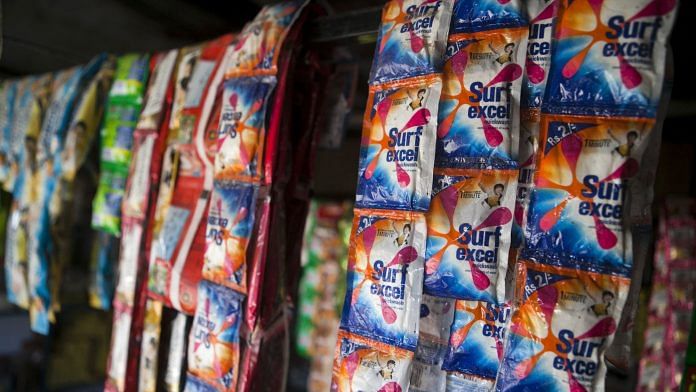If it really wanted to get ahead of the inflation challenge, India’s central bank should have paid more attention to Surf Excel.
The price of the laundry detergent went up by 20% in January. While that’s hardly news when most everyday things are becoming dearer everywhere, the interesting part was the retail price before the change: Rs 10 (13 US cents) for a bar.
Such tiny bars of detergent are targeted at less affluent consumers who are often unable to spend a rupee more without having to cut back on something else. To prevent these customers from downgrading to cheaper products, Unilever Plc’s India franchise relies on “magic price points” — such as Rs 5 or Rs 10 — that help buyers stay within their tight budgets.
“Almost 30% of our business comes from packs that operate at magic price points,” Ritesh Tiwari, the chief financial officer of Hindustan Unilever Ltd., the Indian unit, said on the December quarter earnings call. For these packs, the firm’s preferred mode of exercising pricing power is to cut weight. “As a result, even the same number of units sold leads to volume decline,” he said.
Which is why most of the 11% growth in Unilever’s India sales in the final three months of 2021 came from price increases. The underlying volumes — commodities going out the factory doors — rose only 2%. Rivals fared worse. India’s broader consumer industry saw volumes fall, with rural areas recording a 4.8% decline, compared with a 0.8% drop in cities, according to NielsenIQ.
As India’s largest consumer business, Unilever managed to walk a tightrope between quantity and price. But then commodity cost pressures became too intense to keep up the illusion of affordability. Hence, the January bump, when a Rs 10 Surf Excel bar got marked up to 12 rupees, and the cheaper Wheel brand of detergent powder saw its price raised by Rs 1 to Rs 31 for a half kilo.
This capitulation of some small packs to non-magical pricing — plus the 41 mentions of “inflation” on that quarterly earnings call — should have given the Reserve Bank of India a warning: The dam was breaking; costs were weighing too much on even the profitability of large firms for them to observe the niceties of consumer psychology.
Yet, to delay what even then looked like an inevitable increase in interest rates, the RBI went ahead and projected inflation at a benign 4.5% for the financial year ending in March next year. That was in February. The first rate hike — a 40 basis point move — came on May 4. By then India’s inflation problem was already entrenched, and getting worse. Last month, the 500-ml pouch of Vim dishwashing liquid went up from Rs 1 less than the magic price of Rs 100 rupees to Rs 4 more.
Pranjul Bhandari, the India economist at HSBC Holdings Plc in Mumbai, estimates that only about half of the increases in input costs over the past six months have been passed on to output prices. The cost pass-through is faster in rural areas where unregulated prices of kerosene and bulk diesel have risen more quickly than regulated prices of electricity in cities, she says. “As electricity tariffs are raised over the next 12 months, the urban cost of production and living could hurt growth.”
Not only electricity. Services demand is still trying to catch up with pre-pandemic levels. As the ongoing recovery in contact-based industries like travel progresses, they will pass on some of their own cost pressures, mimicking the strategy of consumer-goods firms. Add expensive food to this list, and it’s unclear if April’s 7.8% inflation rate will go back to 4% — the midpoint of the central bank’s tolerance range — any time soon. That muddies the outlook for how high India’s interest rates need to go, and how much of output growth will have to be sacrificed.
What Unilever calls its magic price points, Dabur India Ltd., a homegrown maker of hair oil and honey, describes as “sacred,” Bloomberg News reported Friday. When companies cut weights to defend prices, they also hope that the consumer will return more often. That doesn’t always happen.
Operating at magic price points is like running a high-school experiment in “titration,” dripping a liquid of known properties into another of unknown concentration and stopping when the color changes. Except that unlike any substance in the lab, the consumer is an active participant in this experiment. In a country where families earning less than the median household income of roughly $2,300 account for only 10%-15% of overall consumption, a large number of people “would be very conscious about the money outlay and they would be titrating the volume to protect their wallet because their wallet is so small and so limited,” Hindustan Unilever Chairman Sanjiv Mehta said on the earnings call.
At 8.3%, inflation in the US is also stubbornly high, but at least unemployment there is at a low 3.6% and hourly earnings are rising. In India, it was only in April that employment surged by 7 million after a cumulative decline of 10 million in the previous three months, according to the Center for Monitoring Indian Economy. Of the 900 million who’re eligible to work, only two-fifths are employed or looking for jobs.
Perhaps the central bank wanted a stronger labor market recovery before raising interest rates. But at least in January — a month before the start of the Ukraine war — it should have read the worrying signs from magic prices. Now it will have to work harder, both to slay inflation and to compensate for its loss of credibility. –Bloomberg
Also read: Modi govt plans tweak to Gold Monetisation Scheme, wants you to share price-fluctuation risk






